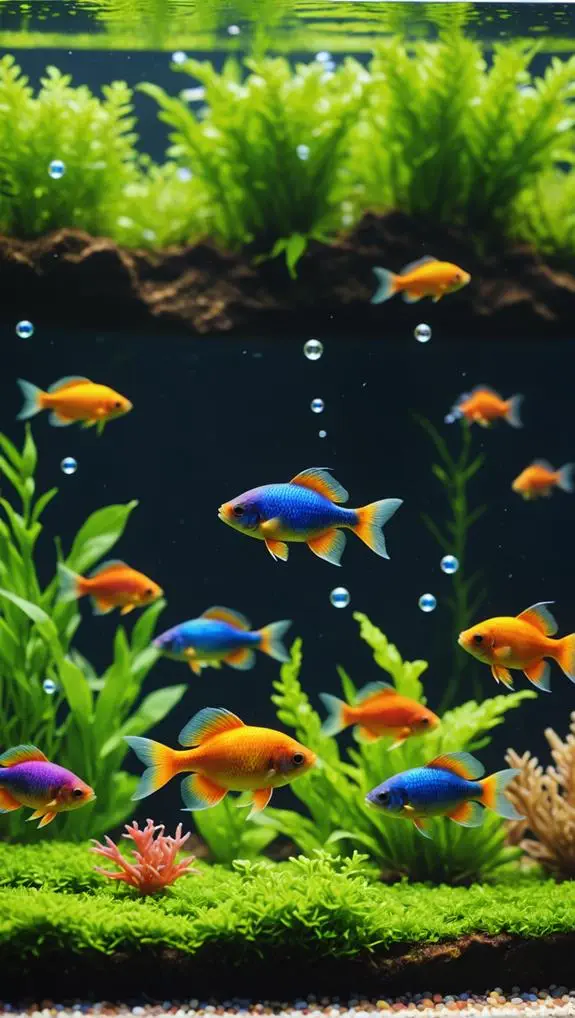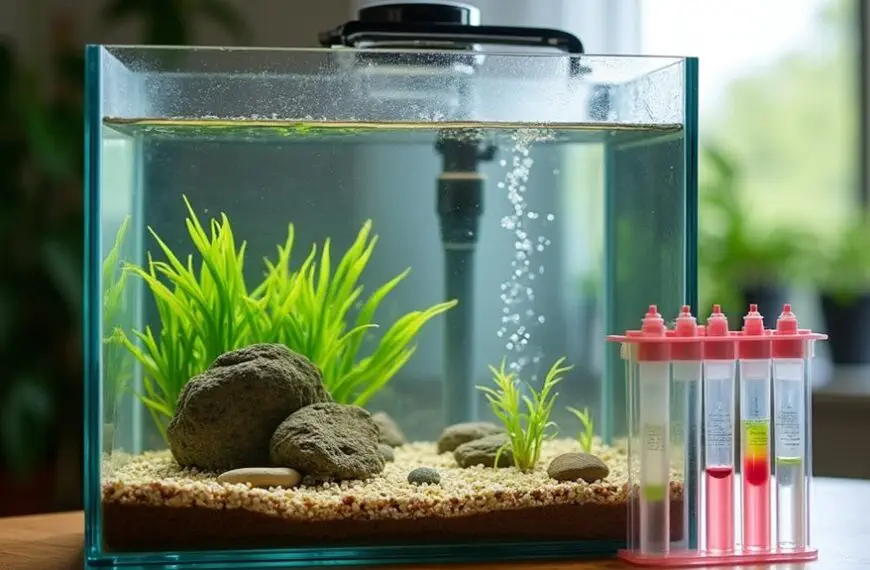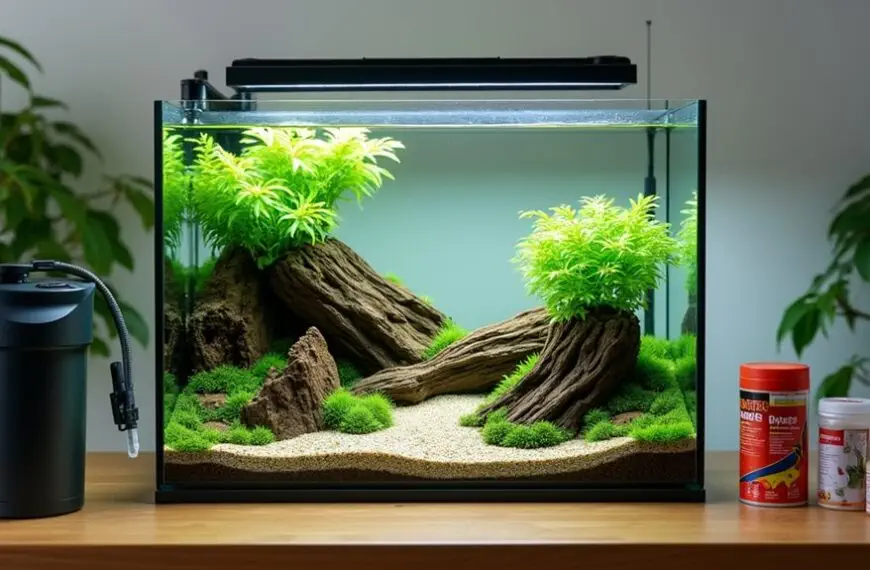Mastering fish tank cycling is all about creating a safe, happy home for your aquatic buddies! Start with fishless cycling using ammonia to grow those all-important beneficial bacteria. Keep an eye on your filter, heater, and aeration—these are your new best friends! Regularly test ammonia and nitrite levels, aiming for zero before introducing any fish. It's a patience game, so don't rush it; remember, good things come to those who wait! When you're ready to add fish, be sure to acclimate them slowly. Curious about more tips to keep your tank thriving? There's a lot more to explore!
Contents
Understanding Fishless Cycling
Fishless cycling is a smart way to establish the beneficial bacteria your aquarium needs without putting any fish at risk. You'll use pure ammonia as a nitrogen source, which means you can create a healthy environment without the stress of traditional methods. This cycling process usually takes days to weeks, helping your bio-filter grow faster than if you were to cycle with fish that might suffer from harmful ammonia and nitrite levels.
During fishless cycling, you'll want to keep ammonia levels around 4ppm for optimal bacterial growth.
Don't forget to test the water regularly! It's crucial to monitor nitrite levels and perform water changes — about 50% — to manage any spikes. This will keep things safe for your future fish.
If you're eager to speed things up, consider seeding your tank with material from an established aquarium. Just make sure that donor tank is healthy!
Once your tank is cycled, you'll have a thriving home for your fish.
Essential Equipment and Preparations
When you're getting ready to cycle your fish tank, having the right gear makes all the difference.
You'll need a solid filter, a heater, and a good ammonia test kit, along with a water conditioner to prep your water for those little swimmers.
Plus, keeping an eye on water quality is key, so grab your test kits and get ready to monitor those levels like a hawk!
Required Equipment Checklist
To successfully cycle your fish tank, you'll need several essential pieces of equipment that ensure a stable and healthy environment for your aquatic life.
First, invest in a high-quality filter to keep the water clean and support beneficial bacteria growth. You'll also want a reliable heater to maintain the right temperature for your fish and bacteria.
Next, grab an API Master Test Kit. This handy tool helps you monitor ammonia, nitrite, and nitrate levels, keeping your tank safe. For fishless cycling, 100% pure ammonia is key, so don't forget that!
To treat tap water, use a dechlorinator like Seachem Prime, which makes your water safe for your future fish buddies.
Oxygenation is crucial, so consider adding air stones or air pumps to boost oxygen levels. If you can, snag some filter media or decorations from an established tank; they'll bring in beneficial bacteria and speed up the cycling process.
Lastly, set up a water testing schedule, checking levels every few days to ensure a smooth cycling journey. With this checklist, you're well on your way to creating a thriving aquatic paradise!
Water Quality Monitoring
Monitoring water quality is essential for ensuring a healthy environment during your fish tank's cycling process. You want your future fish to thrive, and that starts with understanding the water parameters. A reliable test kit, like the API Master Test Kit, is your best friend here. This handy tool will help you keep an eye on ammonia and nitrite levels, which should be tested every 2-3 days.
During the cycle, aim for ammonia levels between 2ppm and 5ppm, while nitrites will rise and eventually drop to zero as beneficial bacteria set up shop in your tank.
Don't forget about pH levels, either! Keeping them between 6.5 and 8.0 is crucial for your bacteria buddies to flourish. When you need to refill the tank, always use dechlorinated water. Chlorine can mess with those helpful bacteria and throw off your water quality readings.
Monitoring Ammonia and Bacteria Levels

Regularly checking ammonia and bacteria levels is crucial for ensuring a successful fish tank cycling process.
You'll want to test every 2-3 days, keeping those ammonia levels around 2-5 ppm. This range helps beneficial bacteria thrive, so you can cycle your tank without any hiccups. If ammonia levels exceed 7 ppm, it's time to act fast! A spike like that can stall your cycle, and we definitely don't want that.
As you keep dosing ammonia to the tank, remember, it's all about feeding those helpful bacteria. They multiply and create a robust biological filter, which means your tank can handle fish in no time.
Also, don't forget about your water parameters! Keeping an eye on pH is essential since you want it between 6.5 and 8.0 for optimal bacterial health.
Once you notice that both ammonia and nitrite levels consistently hit 0 ppm 24 hours after dosing, you can celebrate—the cycle is complete!
Troubleshooting Cycle Stalls
Cycle stalls can be frustrating, but don't worry; they're often just temporary setbacks. The cycling process can take time, and sometimes, beneficial bacteria just need a little boost. One common reason for stalls is nutrient depletion. When ammonia levels drop too low, your bacteria mightn't have enough food. Adding pure ammonia can help rejuvenate the cycle, keeping levels around 2-5ppm.
During these stalls, patience in cycling is crucial. Regularly testing for ammonia and nitrite levels will help you monitor water parameters effectively. If you notice a stall, consider doing partial water changes of 10-30%. This can help eliminate toxins without disturbing the bacteria colonies.
Another great tip is to use seeded materials from established tanks. Adding filter media or substrate from a healthy aquarium can introduce beneficial bacteria to jumpstart the process.
Final Steps Before Adding Fish

Before you introduce your fish to their new home, it's crucial to ensure that the tank is in optimal condition. Start by conducting a significant water change—aim for 75% or more. This helps reduce nitrate levels and creates a safer environment for your aquatic friends.
Next, continuously monitor ammonia levels; they should be at 0 ppm to confirm your beneficial bacteria are doing their job.
Don't forget to test the pH levels! Ideally, it should be stable within 6.5 to 8.0. This range is like a cozy blanket for your fish, promoting their health and happiness.
When it's time for adding fish, remember the golden rule of gradual introduction. Add only 50% of the tank's capacity at first—this way, you'll help mitigate stress and avoid territorial disputes.
Lastly, don't skimp on the water conditioner. Using something like Seachem Prime will detoxify any leftover ammonia or nitrite.
Your fish will appreciate your efforts, and you'll feel like a proud aquarium parent. With these final steps taken, you're all set for the exciting moment of welcoming your fish into their new aquatic paradise!
Ongoing Maintenance and Care
Now that your tank is cycled and ready for fish, it's time to keep things running smoothly.
You'll want to make regular water changes of 10-20% each week to keep those pesky nitrates in check and ensure your fish stay happy.
Plus, don't forget to keep an eye on ammonia and nitrite levels—after all, nobody wants a surprise party for those little guys!
Regular Water Changes
While maintaining a healthy aquarium environment, regular water changes are essential for keeping your fish thriving. You should aim for 30-50% water changes every 1-2 weeks. This practice helps manage your tank's ammonia levels and nitrite levels while reducing toxins that can harm your fish.
Plus, it promotes a stable aquatic environment, making your fish feel at home!
Don't forget; water changes also replace essential trace elements and minerals that might get depleted over time. Before adding new water, use a reliable water conditioner, like API STRESS COAT™, to dechlorinate tap water. This simple step protects your fish from harmful chlorine and chloramines.
Regular water changes play a crucial role in fish health, helping prevent algae blooms and keeping your water crystal clear.
Who wants a murky tank, right? By testing for nitrates before and after changes, you can ensure your aquarium stays in tip-top shape.
Monitoring Water Parameters
Monitoring water parameters is crucial for maintaining a thriving aquarium environment.
When cycling your tank, you should test ammonia, nitrite, and nitrate levels every 2-3 days. This helps you catch any spikes before they become a problem. Aim to keep ammonia levels between 2-5ppm; anything over 7ppm can stall your cycle and harm those all-important beneficial bacteria.
You'll know you've successfully cycled when both ammonia and nitrite levels hit 0ppm within 24 hours after dosing, and you see some detectable nitrates.
Remember, nitrates need managing too! Regular water changes of 30-50% are a must, especially before introducing any fish, so you keep their new home safe and sound.
Don't forget to document test results! Keeping track of changes won't only show your progress in the nitrogen cycle, but it also helps you make timely adjustments for your fish's health.
If you're ever unsure, don't hesitate to pop into your local fish store. They can guide you through the maze of water parameters, ensuring your aquatic friends swim happily.
After all, happy fish make for a happy tank!
Frequently Asked Questions
How to Cycle a Fish Tank Step by Step?
To cycle your fish tank, use ammonia sources to kickstart the nitrogen cycle, monitor water quality with test kits, nurture beneficial bacteria, avoid common mistakes, and consider live plants for efficient cycling duration and tank maintenance.
How Long Should You Cycle a Tank Before Adding Fish?
Before adding fish, you should cycle your tank for 4 to 6 weeks, ensuring ammonia levels reach zero. Consider fishless cycling for faster results, but always test water parameters and nurture beneficial bacteria during this critical duration.
What Is the Best Temperature to Cycle a Fish Tank?
The ideal temperature for cycling a fish tank is 78°F to 82°F. Maintaining stable water parameters boosts beneficial bacteria growth, helping manage ammonia levels and nitrite spikes. Avoid temperature fluctuations for optimal results and cycle duration.
How Do I Know if My Tank Is Properly Cycled?
Think of your tank as a garden. To know it's properly cycled, test ammonia levels, observe nitrite spikes, check nitrate presence, and monitor fish behavior. Ensure water clarity and perform regular water changes using test kits.
Final Thoughts
You've now got the tools to master fish tank cycling! By understanding the process, preparing your equipment, and keeping an eye on ammonia and bacteria, you're setting yourself up for success. When you troubleshoot stalls and finalize your tank, you're not just ready to add fish; you're creating a thriving underwater world. Remember, cycling takes time, patience, and a little love. So, dive in, enjoy the journey, and soon enough, you'll be the proud parent of some happy fish!












